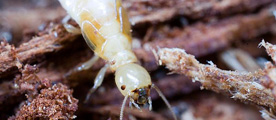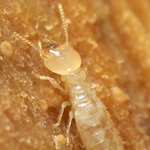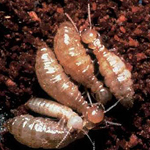Pest Info » Termites

Termite
Termite Control and Termite Treatment
It is very important that pest control problems be addressed immediately. Delayed termite treatment causes a lot of damage as the termites can chew through almost anything. These termites attack building structures such as roof trusses and compromise the safety of the occupants of your premises. They destroy your stock and damage your property.
What is Termites?
Termites are small soft bodied insects, which many people call "white ants", There are many different termite species in Malaysia, some are important recyclers of dead and decaying timber,
These species are subterranean, they constantly forage and evaluate the size and quality of food resources as they seek out cellulose, the primary component of wood.
Termites live and work together in large groups known as colonies. They are divided into various groups known as castes; the Queen, king, soldiers, workers and alates.
Termite Colony
Nymphs

While in the nymph state, termites diverge into different castes: workers, soldiers, reproductives and supplementary reproductives.
Workers

Most termites are workers, with soft, light-colored bodies rarely more than 10 mm long, like grains of rice. They are blind, wingless termites that maintain the colony, build and repair the nest and care for others termite. They rarely leave the dark tunnels that run from the colony through the soil and into the wooden frames of buildings. Twenty-four hours a day, they forage for food, maintain the nest, and tend the queen and her brood. Juveniles, called nymphs, groom and feed one another and others in the colony.
Soldiers

Soldiers are sterile, wingless and blind. They have long heads with powerful jaws and are responsible for defense colony, primarily against invading ants
Reproductive

Reproductive male and female termites will eventually leave the colony as adult "Swarmers" to mate and start new colonies.
Queen

The queen is the largest colony member, up to 10 cm long, about the size of the space bar on your computer. She's so big that if she needs to move, it requires several hundred workers pushing at once. She lays an egg every 15 seconds. If she dies, another reproductive takes her place. Some Queen termite can live for as long as 30 years.
Termite Warning Signs & Identification
- A temporary swarm of winged insects in your home or from the soil around your home.
- Any cracked or bubbling paint or frass (termite droppings).
- Wood that sounds hollow when tapped.
- Mud tubes on exterior walls, wooden beams, or in crawl spaces.
- Discarded wings from swarmers.
Control Methods
- Pre-construction soil treatment
- Treatment is carried out when the building is still under construction. Termiticide is sprayed over the entire built up area after compaction and just before laying of the concrete floor slab.
- This conventional treatment can only last between 2-3 years depending on the type of termiticide used. The termiticide cannot last forever and once the chemical bio-degrade in the soil there is no more protection.
- Post Construction Soil Treatment
- This involves having to drill holes into the floor along walls and also along the perimeter of the building and pumping insecticide into the soil under the slab.
- Termites coming into contact with the chemical barrier would be killed.
- This treatment can last between 3-5 years depending on the type of termiticide used for the treatment.
- Baiting & colony elimination system
- Baiting and colony elimination is the latest technology having been introduced into Malaysia in the year 2000. It takes advantage of the behaviour of termites.
- Baiting with Chlorfluazuron will result in colony elimination. The baiting process takes between 70-90 days from the date the termites start to feed on the bait matrix.
- It is by far the most effective termite control system available today. However, this system can only be recommended for use on the subterranean termite species called Coptotermes sp.
- This baiting system does not require drilling and pumping of chemicals in the building or in the house therefore the flooring will not be damaged at all.
- The chemical Chlorfluazuron is an insect growth regulator (IGR) and is therefore friendlier to the environment and the people around it.
- Residue Spraying
- This method is not much recommended as it may be cause greater problems in the future especially when the termites attack other parts of the building or the house which is inaccessible or cannot be easily detected.
- Spot treatment using different termiticides will not solve the termite colony problem. The termites will merely retreat and move away to another spot where there is food.
- Treatment with incorrect termiticides may leave behind a strong repellency which takes months to disappear. After the smell is gone, the termites may eventually come back again.
Pest Info
Company Address
ONE STOP PEST CONTROL 921332-T
40, Jalan USJ 8/2A, UEP Subang Jaya, 47610 Selangor, Malaysia
Tel: +603-5633 8501
Fax: +603-5879 8501
Email: onestop-pest@hotmail.com
JB Branch
ONE STOP PEST CONTROL ( Southern ) SDN. BHD. 1325838-M
42-1, Jalan Setia Tropika 1/1 Taman Setia Tropika, 81200 Johor Bahru, Johor
Tel: 07-232 0951/ 017-877 0951
Email: ospc.southern@gmail.com
